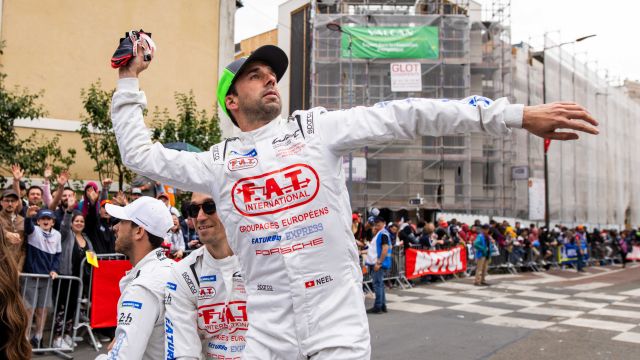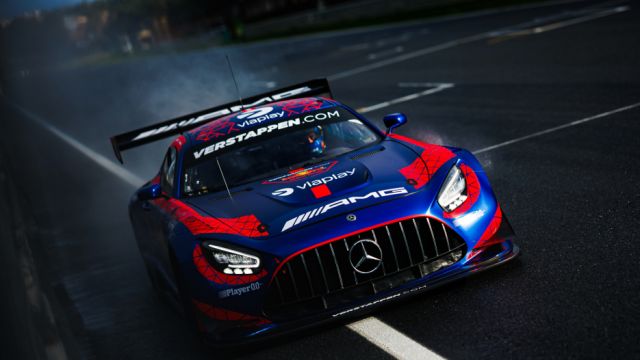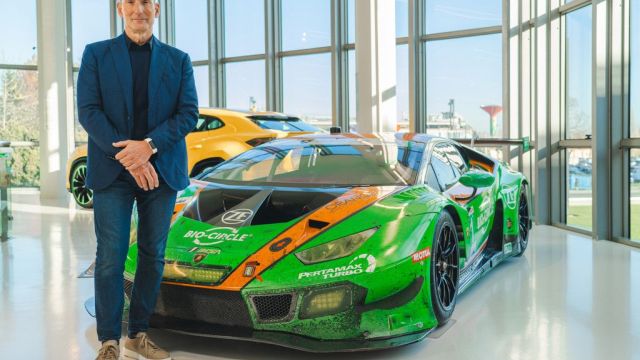Scherer-Audi wins the shortest “Eifel Marathon” in the long 24h history
A novelty and a new record winner: Scherer PHX wins what is probably the most extraordinary and definitely the shortest “Eifel Marathon” in the long history of the ADAC RAVENOL 24h Nürburgring and catches up with its Meuspath neighbor and record winner Manthey with its seventh overall victory.
Ricardo Feller drove the #16 Scherer-Audi across the finish line at 3.05 pm on Sunday afternoon, the first time it had crossed the line before the end of the 24 hours - and also the first time it had been neutralized and driven slowly due to fog. Celebrating together with Feller were Dennis Marschall, who like the Swiss celebrated his first 24-hour victory, and the two Audi “veterans” Frank Stippler and Christopher Mies, who each celebrated their third triumph in the Eifel in front of 240,000 spectators (overall weekend).
“I've known the mechanics since 2009 when I started at Audi. It's nice to finish this here with a victory together,” said Mies after what was probably his last race in an Audi. The other places on the podium went to the #911 Manthey-Porsche with Laurens Vanthoor, Thomas Preining, Kevin Estre and Ayhancan Güven and the #72 RMG-BMW with Daniel Harper, Max Hesse and Charles Weerts. Like ten other cars that were still on the lead lap after the race was interrupted, these two teams no longer had any chance of attacking the leaders in the final phase, despite the elimination of the previous time gaps.
This was because the last five laps were completed in neutral behind a lead car. After a 14-hour break due to fog, the ninth and second-longest interruption of the traditional race ever, the race was restarted at 13:30. However, as visibility did not improve sufficiently, race director Walter Hornung had to call off the race prematurely. It is the first victory for an Audi since 2022. Stippler had previously won in the “Green Hell” in 2012 and 2019, Mies in 2015 and 2017.
Spectacular start phase after “punctual” rain intervention
Shortly before the start of the formation lap, it began to rain in various places on the track. While Harper, who was on pole, remained on treadless dry tires, his direct pursuers quickly switched to rain tires before race director Walter Hornung sent the first starting group on their journey into the “Green Hell” with the green flag. It was the wrong decision for Harper's team, as the Briton headed for the pits before the race was cleared and also had rain tires fitted, which initially dropped him back to 21st place.
At the front, Estre in the #911 Manthey-Porsche defended the lead he had taken without a fight against Maro Engel in the #130 Getspeed-Mercedes-AMG and Farfus in the #99 Rowe-BMW, who had moved up from seventh on the grid. Engel took the lead on the Grand Prix circuit and led the field out onto the Nordschleife for the first time. However, the tire poker didn't work out for him there either, as Engel was passed through to 24th place on hand-cut slicks in the further course of the first lap and then also took rain tires.
Estre and Farfus then fought a private duel at the front, often less than a second apart, swapped the lead four times and after four laps already had a 37-second lead over the third-placed #16 Scherer-Audi, which Harper had fought his way back into the lead with a fantastic chase. After the first pit stops, the #99 Rowe-BMW led the field for a long time until Sheldon van der Linde was hit by a slower car while lapping and was involved in a violent three-car crash. This ended the Rowe BMW's dream of victory. As darkness fell, Mies in the #16 and Harper again provided the best entertainment and fought tough but fair duels for the lead. When the race was red-flagged at 23:23 due to the increasing fog, the Audi driver was ahead.
Restart after a long break in the fog
It was the ninth interruption in the history of the race. The first had been in 1992, the last so far in 2021 - this was also the longest to date with a 14.5-hour stoppage due to fog. In 2020, heavy rain during the night caused a forced break of 7.5 hours. In 2018, the race was interrupted three hours before the end due to fog, and the decision was made after the restart in a 90-minute “final sprint”. As the fog persisted on Sunday morning, the restart had to be postponed again and again. It was not until 13:30 that race director Walter Hornung green-flagged the race, which finally came to an end behind a lead car.
“I would like to thank all the fans who turned this week into a huge motorsport festival and celebrated the 24h Nürburgring with us despite all the capricious weather,” said Hornung. “I would like to thank the participants and teams for their understanding that we were able to bring this special race to a close in this way.”
The next ADAC RAVENOL 24h Nürburgring will take place from June 19 to 25, 2025.






Comments
Log in to comment the article